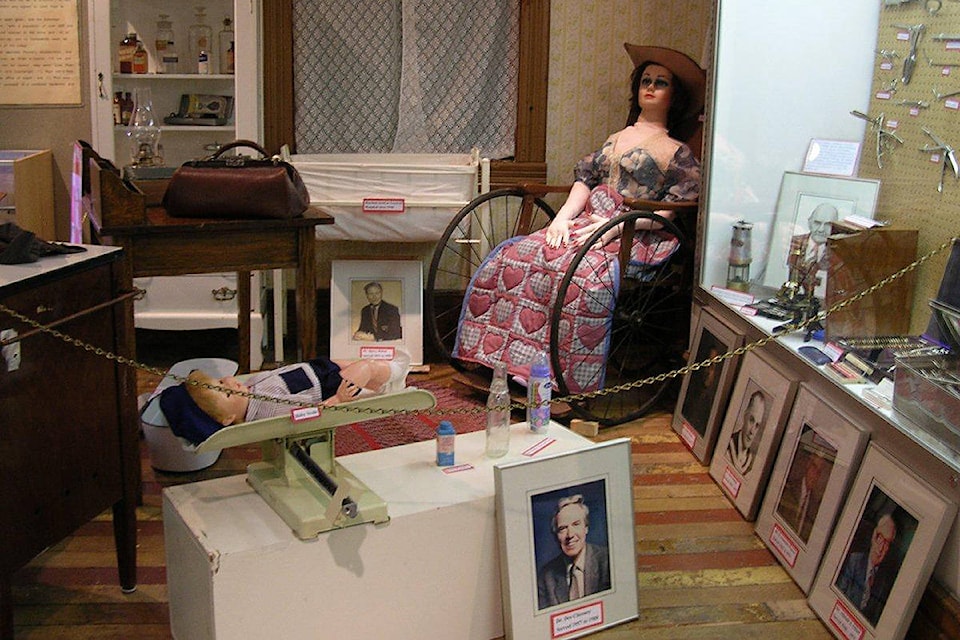By Mike Rainone for the News
I always look forward to my casual weekly visits with Sandy and Sharon and the summer staff at the Fort Ostell Museum, who have always so kindly assisted me to pursue the great material and photos for my Reflections and Remember When Ponoka News features, as well as usually spoiling me with a tasty variety of coffee, cookies, and home-made treats.
Last Wednesday I was allowed to get up close and personal with an amazing new display that visibly reveals the colourful history of our earliest medical services, treatment, and personnel in the town and surrounding districts of Ponoka.
The delightful and vivid new feature is called ‘The Doctor’s Office’ and is located in the museum’s exciting display room, which very authentically reveals and tells the exciting and colourful stories from over a century of history, challenges, and successes for countless generations of hardy pioneer families and individuals of all ages. I have to admit that I was quite overwhelmed and just a little bit squeamish to see and even touch some of those ominous stainless steel instruments that our skilled early physicians actually used to endeavour to bravely treat, solve, and cure the countless ailments of their early patients.
Just the names of some of these first humble medical utensils may scare you just a little, but they included: forceps and snares to remove tonsils and adenoids, a bone nibbler, an endoscope tube, bowel forceps, dental forceps, abdominal retractor and suction, metal catheter, rectal scope, a tuning fork, oral irrigator, skin graft knife, bone cutter and cordette, a 1908 microscope, a mercury sphygmomanometer, and all sorts of very sharp and shiny scissors, tweezers, and scalpels. In those rugged early days there were very few hospitals, and many of the sudden surgeries, treatments, and deliveries had to be performed in the physician’s office, kitchen table, or elsewhere in dark and tight conditions under the dim light of the fireplace, stove, or lantern, with only the assistance of a nurse, mid-wife, husband, wife, or neighbour.
Also included in this great family display is a replica of how one of the first doctor’s offices in Ponoka may have looked and greeted patient’s starting way back in the early 1900s. Featured are an original wooden wheel chair, infant’s cradle and weight scales, the good physician’s bag on a tiny desk, prescriptions written by Dr. Melvin Graham in 1919, original babies bottles, a medicine cabinet full of everything from epsom salts to castor oil, an original (what must have been really cold) ceramic bed pan, and so much more in this grand salute to early local medicine. Many of the items in this colourful display were kindly donated by the families of our original physicians and staff, as well as from the Ponoka General Hospital and other medical practitioners and services who have faithfully served the most vital needs of the rapidly growing town and county of Ponoka for countless decades. Here are just a few of the countless milestones of that great era of excellent professional care and kindness that generations of our residents have received over many decades of never ending hardships and challenges, all of which has allowed our community to thrive and achieve so many successes along the way, and that same compassionate care still carries on to this day.
• Dr. Angus A. Drinnan was Ponoka’s first physician, arriving here in 1902, and his photo is included in the Fort Ostell Museum display along with some of our earliest Doctors.
• Dr. Melvin Graham, a graduate of the Toronto University Medical School arrived in Ponoka with his new wife all the way from London, England in 1912. As well as being a family physician he also specialized in eye refraction and diseases of the eye, and his original case of lenses and instruments is also included in our new FOM feature. Dr. Graham’s practise and residence was located on 51st (Donald Avenue) in Ponoka, where he faithfully maintained his amazing devotion to his profession, his community, and his family until his death in 1962.
• In the early days recovering patients were cared for by nurses in local residences or small nursing homes, and if hospitalization was required they would have to be taken to Lacombe or Wetaskiwin by horse and wagon or by train. Those hardy early 24-7 physicians made their ‘house calls’ in town or out into the country by horse and buggy by the light of a coal miner’s lamp at night, and later in cars or trucks in year-round unpredictable road and weather conditions. Ponoka’s first hospital was built in 1946 at the north end of 50th Street, and was replaced by our present ultra-modern Hospital and Care Centre facility in 1987. The unique new medical display at the Fort Ostell Museum in Ponoka is dedicated in appreciation of the extreme efforts and in the memory of those countless men and woman who have served and continue to serve in all facets of this most vital profession.
